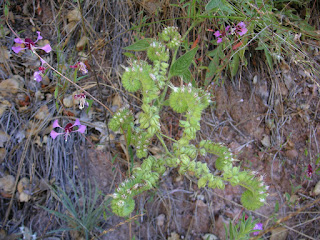After the previous day's hot hike in the full sun, our hike to Bear Gulch Reservoir in the shade of rocks and trees was a welcomed change of pace. For all the times we've been to Pinnacles, this was the first time we've done this short loop. Unfortunately our timing never seems to coincide with when Bear Gulch Cave is open. As shown by the sign, the cave is often closed when the Townsend's big-eared bats are raising their young. Plus, this past March I know the Balconies Cave was closed due to high water, but I don't remember if Bear Gulch Cave was also closed.
While we prefer going to the west entrance in May for a day trip, this was our first time camping at Pinnacles. The last picture shows our campsite's "backyard" with a creek. It looks lovely, doesn't it? Come nightfall, marauding racoons used that creek to sneak into every campsite along the water. We could hear the series of shrieks and yells from the campers with only a minute or so between hits. We were sitting only feet away at the campfire when a couple very large raccoons hopped on our table and grabbed our just-opened bag of marshmallows. We got off easy. Our neighbors chased after a raccoon which disappeared with an entire knapsack. Overall, this Pinnacles trip was great and I'm looking forward to going back.
ps 12/15/11 - For pictures of this trail in mid-December, check out My Back 40 (Feet).
While we prefer going to the west entrance in May for a day trip, this was our first time camping at Pinnacles. The last picture shows our campsite's "backyard" with a creek. It looks lovely, doesn't it? Come nightfall, marauding racoons used that creek to sneak into every campsite along the water. We could hear the series of shrieks and yells from the campers with only a minute or so between hits. We were sitting only feet away at the campfire when a couple very large raccoons hopped on our table and grabbed our just-opened bag of marshmallows. We got off easy. Our neighbors chased after a raccoon which disappeared with an entire knapsack. Overall, this Pinnacles trip was great and I'm looking forward to going back.
ps 12/15/11 - For pictures of this trail in mid-December, check out My Back 40 (Feet).































